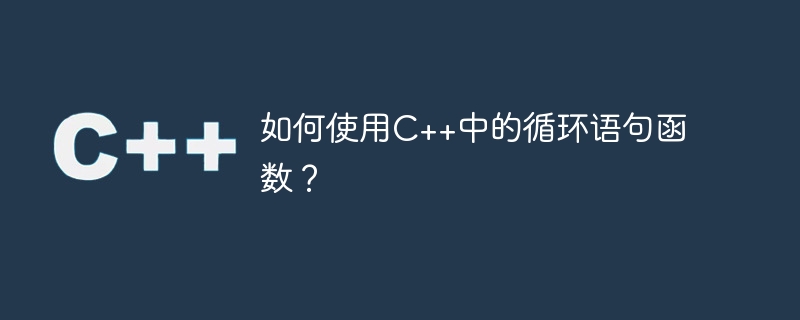

How to use the loop statement function in C?
C is an object-oriented programming language with powerful loop functions that help developers perform repetitive tasks more efficiently. The loop statement function can create a loop in the code to execute the same piece of code multiple times, thereby simplifying the programming process and improving the readability of the code.
In C, we use loop statement functions to execute different types of loops, including for loops, while loops and do-while loops. Different loop types are suitable for different programming needs. Below we will introduce these three loop statement functions respectively.
for loop: The for loop is used to repeatedly execute a block of code. Its syntax is as follows:
for (初始化表达式; 条件表达式; 更新表达式) {
// 执行的代码块
}The initialization expression is executed before the loop starts, and the conditional expression The expression is used to determine whether to continue executing the loop, and the update expression is executed after each loop iteration. Usually, the initialization expression is used to set the initial value of the loop variable, the conditional expression is used to determine whether to continue executing the loop, and the update expression is used to update the value of the loop variable.
while loop: while loop is used to repeatedly execute a block of code when the specified condition is true. Its syntax is as follows:
while (条件表达式) {
// 执行的代码块
}When the conditional expression is true , the loop will continue to execute. The conditional expression is re-evaluated after each execution of the code block. If the condition is false, the loop stops.
do-while loop: The do-while loop is similar to the while loop, except that the order of conditional judgments is different. Its syntax is as follows:
do {
// 执行的代码块
} while (条件表达式);The do-while loop first executes the code block and then evaluates the conditional expression. If the conditional expression is true, the loop continues; if the conditional expression is false, the loop stops.
When using the loop statement function, we can choose different loop types according to actual needs. For example, if we know the number of times to loop, we can use a for loop; if we need to loop infinitely when a condition is true, we can use a while loop; if we want to execute the loop at least once, we can use a do-while loop.
In addition to the above commonly used loop types, C also provides other related loop statement functions, such as nested loops and loop control statements (such as break and continue). Nested loops can contain one loop within another loop, allowing for more complex programming logic. Loop control statements can control the behavior of the loop during loop execution, such as skipping the current iteration or terminating the loop.
The loop statement function is very useful when writing programs and can help us save time and energy. Accurate use of loop statement functions can improve the efficiency and reliability of the code, and also improve our work efficiency as developers. Therefore, mastering the loop statement function in C is one of the necessary skills for every programmer.
To sum up, using loop statement functions in C can make the code more concise and readable, and improve programming efficiency in repeated tasks. Being proficient in different types of loop statement functions and using them flexibly based on actual needs can help us better solve programming problems. Through study and practice, we can gradually improve our ability to write loop code.
The above is the detailed content of How to use loop statement function in C++?. For more information, please follow other related articles on the PHP Chinese website!
 What are the differences between c++ and c language
What are the differences between c++ and c language
 Recommended learning order for c++ and python
Recommended learning order for c++ and python
 Cost-effectiveness analysis of learning python and c++
Cost-effectiveness analysis of learning python and c++
 Is c language the same as c++?
Is c language the same as c++?
 Which is better to learn first, c language or c++?
Which is better to learn first, c language or c++?
 The difference and connection between c language and c++
The difference and connection between c language and c++
 C++ software Chinese change tutorial
C++ software Chinese change tutorial
 Cost-effectiveness analysis of learning python, java and c++
Cost-effectiveness analysis of learning python, java and c++




